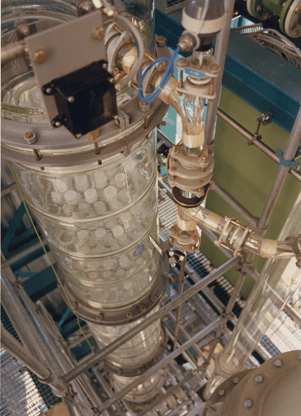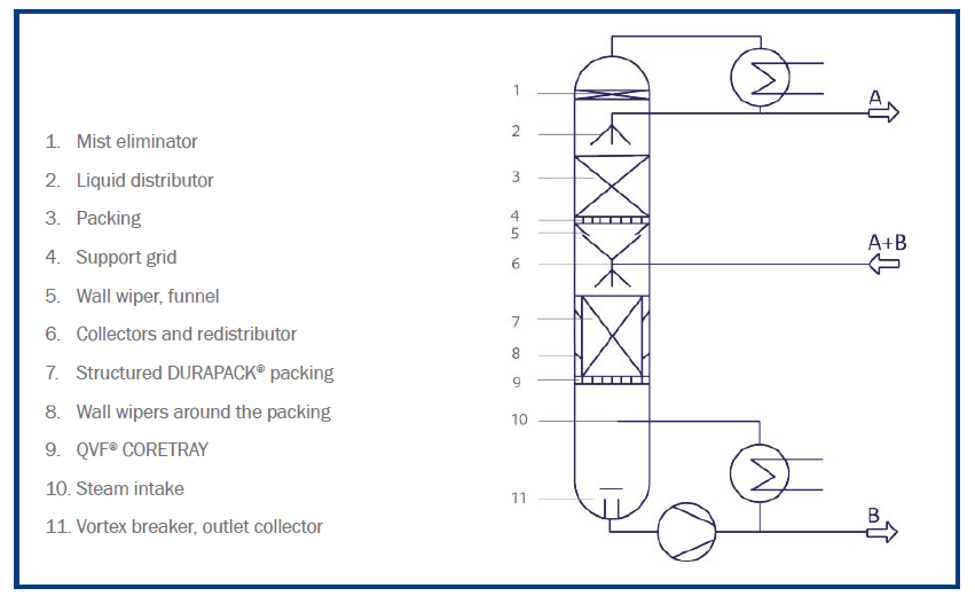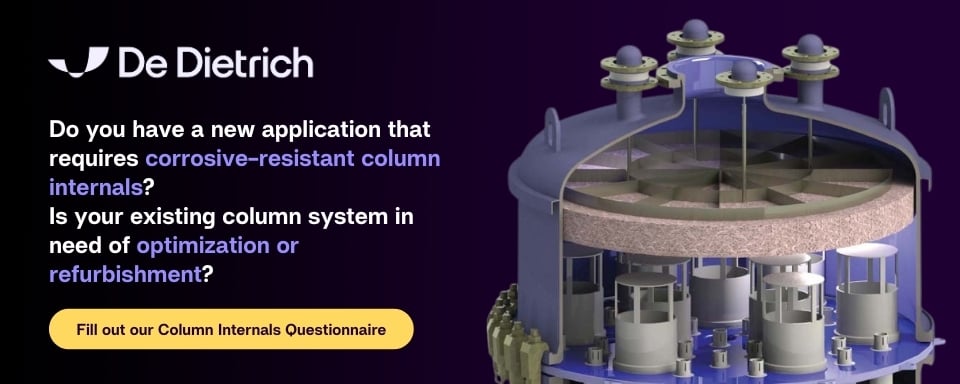An Introductory Guide to Columns and their Internal Components
 Columns are an essential piece of equipment in most chemical processes. As a chemical engineer, this is one of the key subjects you learn in school. But what if you didn’t study chemical engineering and somehow end up in the world of process systems? This article was written to give you an overview about columns, whether you are new to the subject or need a refresher.
Columns are an essential piece of equipment in most chemical processes. As a chemical engineer, this is one of the key subjects you learn in school. But what if you didn’t study chemical engineering and somehow end up in the world of process systems? This article was written to give you an overview about columns, whether you are new to the subject or need a refresher.
Columns are typically used to perform chemical and/or thermal separations. But this requires some internal components, because without all that “stuff” inside, a bare column would be just a pipe. The different elements installed inside columns are what help facilitate the separation process. The diagram below shows typical components found in distillation. In this example, the packed distillation column is used for separating volatile substance A from less volatile component B:

Internal Column Components Defined
Here’s a short explanation of what task each internal has in a column system (refer to diagram above for location):
1. Mist eliminator
Located at the head of the column, these are used to prevent entrainment at the vapor outlet. They can consist of packing or inert fabric.
2. Liquid distributor
This component evenly dispenses the incoming fluid over the column cross-section. The type used (channel, tube, nozzle, etc.) will depend on the different characteristics of your liquid.
3. Packing
Typically, Borosilicate glass structures are used for their temperature allowance and corrosion-resistance. Other materials are available if the conditions of your process require a different option.
4/9. Support grid/QVF CORE-Tray
Our QVF CORE-Trays provide effective support for structured packing, retaining most of the gas flow cross-sectional area and minimizing the pressure drop. Support grids made of different corrosion resistant materials are also used to hold the structure packing in place.
5/8. Wall wiper (funnel, around packing)
Liquid in a column has the tendency to want to run down the inner wall. A wall wiper works to deflect liquid from the column inner wall back into the packing to maximize column efficiency.
6. Collectors and redistributor
Positioned underneath the packing, collectors catch the run-down liquid and either remove it from the column or feed it back to the redistributor.
7.Structured DURAPACK packing
When a high level of separation efficiency is needed, structured packing is used to intensify process objectives. DURAPACK is comprised of alternating arranged corrugated plates of glass with flow channels inclined by 45°. The glass plates are fused together so that the borosilicate glass is the only material in contact with the process fluids.
10. Steam intake
Uniform steam distribution uses the packing efficiently, reducing the overall height of the column.
11. Vortex breaker, outlet collector
Located at the very bottom of the column, these help to ensure reliable liquid drainage and keep run-down liquid from entering the steam inlet.
Design Considerations
There are many factors that need to be considered when designing a distillation column. To determine its size (diameter and height), you need to calculate at the feed and product flows. You should also look at the vapor and liquid loading inside. These terms refer to the vapor traffic and liquid traffic passing through different sections inside the column. The contact between these two flows (vapor and liquid) is what allows for the chemical and/or thermal separation to occur.
Typically, there is also a heating source that helps create vapor inside a column. This can be done via direct heating (steam injected directly into the column), or by utilizing a reboiler (where the bottom liquid is boiled up using a heating medium).
Columns can be operated at a variety of temperatures and pressures, depending on your separation requirements. The design of these columns therefore requires good knowledge and expertise, otherwise you may end up with an inefficient or defective design.
At De Dietrich, we specialize in designing and manufacturing columns specifically exposed to highly corrosive and aggressive media, or that require an inert surface to avoid any contamination of the chemicals being processed and separated (especially in the food, beverage, fine chemical and pharmaceutical industries).
Besides being able to provide you with a shell made of Borosilicate glass or glass-lined material, we have the capability of designing and supplying all the internals (as shown in diagram 1). One of the advantages of using our corrosion resistant internals is that our materials of construction allow the system to operate at higher temperatures compared to the various build materials used by other manufacturers.
If you are interested in learning more about our column capabilities, download our Process Solutions for Mass and Thermal Media brochure or request to speak with one of our sales engineers.
